 Carl Lawson (Photo by Loren Santow) After 8-year-old Terrence Jones was found stabbed to death in an abandoned church near his East St. Louis, Illinois, home in 1989, Carl Lawson, a friend of the child’s mother, was arrested and charged with the crime because bloody shoeprints consistent with shoes he owned were found at the scene.
Lawson insisted that if the shoeprints indeed were his must have left them when he and other residents of the neighborhood arrived at the crime scene after the body was discovered, which was hours after the murder had occurred, Lawson’s contention was disputed by William R. Brandon, a state crime scene analyst, who testified that the shoeprints were made earlier — before the blood had dried — although he had done nothing to test that hypothesis. Lawson requested funds for independent forensic testing before his 1990 jury trial, but St. Clair County Circuit Court Judge Michael O’Malley denied the request. The jury proceeded to find Lawson guilty, and O’Malley sentenced him to death.
On direct appeal, the Illinois Supreme Court held in 1994 that O’Malley had erred in denying funding for the independent forensic analysis and remanded the case for retrial. The ensuing testing established — contrary to Brandon’s trial testimony — that the drying pattern was consistent with Lawson’s contention that the print had been made after the body was found.
The independent forensic finding bolstered a defense theory that the crime had been committed by a drug addict named Milton Wilson, who had been a suspect initially, but had been ruled out as a result of Brandon’s erroneous interpretation of the shoeprint evidence. Like Lawson, Wilson was at the murder scene after the body was discovered. His arms were bloody and appeared to have been freshly scratched. Despite the new forensic evidence, Lawson was retried twice. The first retrial, in 1995, ended with an 11-to-1 jury deadlock. The second, in 1996, ended in acquittal. Wilson was never reinvestigated; he had died of a drug overdose while Lawson’s appeal was pending.
Lawson later received $120,300 in state compensation.
— Rob Warden
|